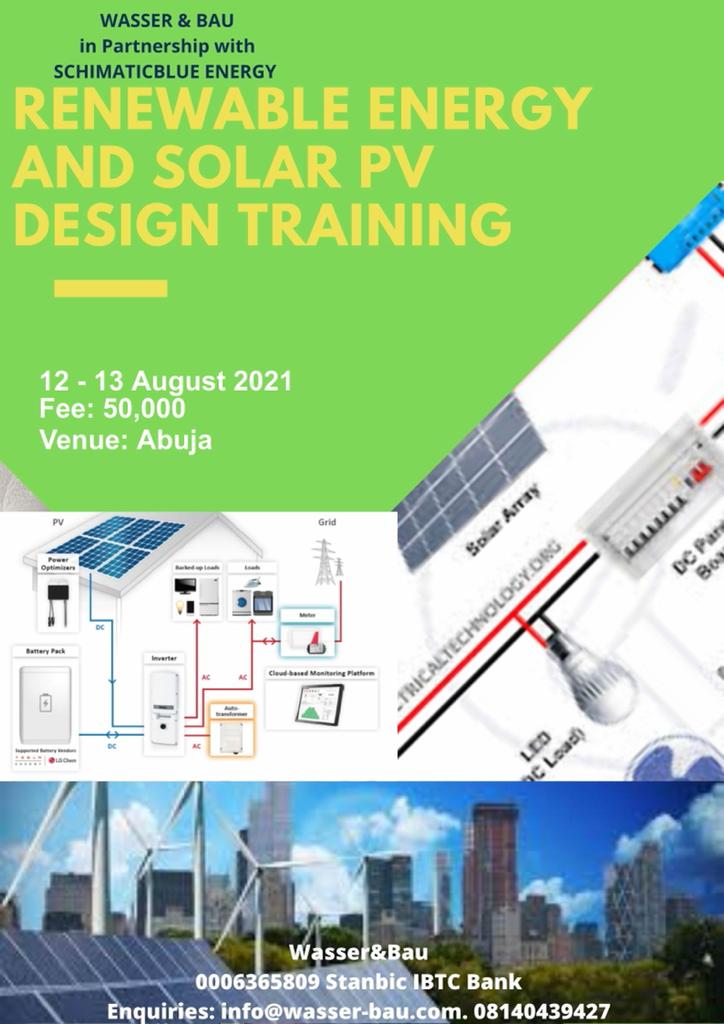RENEWABLE ENERGY AND SOLAR PV DESIGN

About This Training
The training will widely cover the design of photovoltaic systems, such as utility scale solar farms or residential scale systems (both on and off the grid). You will learn about the function and operation of various components including inverters, batteries, DC-DC converters and their interaction with both the modules and the grid.
After learning about the components, you will be able to correctly apply them during main design steps taken when planning a real PV installation with excellent performance and reliability. Through modelling, you will gain a deeper understanding of PV systems performance for different solar energy applications, and proficiency in estimating the energy yield of a client’s potential system.
Who Should Attend
Electrical Designers • Electrical Engineers • Sales Engineers • Electricians • Project Managers • entreprenuers • Installation and Operating Engineers requiring knowledge of PV Solar Systems • energy managers • infrastructure engineers and consultants
| Module 1- Solar PV Application and Design |
| LEARNING OBJECTIVE Upon completion of this module, participants should be able to; Distinguish between off-grid and grid-connected PV systems Distinguish, in principle, the difference between distributed and central PV systems and Name the different components used in grid-connected PV systems and off-grid PV systems Identify the different applications of off-grid PV systems. Identify the basic differences of PV cell types available. Describe the design of PV modules. Explain the function of PV inverters and name different types of inverters. Identify the different types of PV mounting structures and understand the fundamental requirements of mounting structures. Explain the basics of the photoelectric effect, calculate the output of a PV cell and name the main factors influencing the output of a PV cell. Name the basic electrical characteristics of a PV cell and interpret an I-V curve. Identify power output reductions on an I-V curve.Identify the impact of irradiance and temperature on PV cell or module voltage, current and power and describe how the I-V curve changes with changing irradiance levels and changing temperature. Name the standard test conditions (STCs) for PV cells/modules and understand why such STCs are required. Identify the temperature coefficients and how they can be used to determine PV cell voltage, current and power at different temperatures. Define the factors influencing energy yield and calculate the Performance Ratio and describe its use. Calculate the energy yield for a given setting. |
| Module 2- Solar PV System Sizing |
| LEARNING OBJECTIVE Upon completion of this module, participants should be able to; • Explain the basic concept of a mini- and hybrid power system • Learn about different set-ups for PV-diesel hybrid systems • Get to know a specific categorisation methodology for PV-diesel hybrid systems • Define the concept and characteristics of load profiles and ddetermine what is peak load within a load profile • Get to know the different concepts of PV penetration rate • Understand the concept of energy shares in hybrid systems • Understand a genset’s minimum load level for the operation of a PV-diesel hybrid system • Describe the performance in a typical hybrid system on a sample day • Understand the relationship of increasing PV capacity and its meaning for system complexity • Be familiar with the purpose of storage • Get an overview of characteristics of typical storage technologies • Understand the importance of energy efficiency and DSM in a PV-hybrid system |
| Module 3 – Cost Estimation of Solar Systems and Project Evaluation |
| LEARNING OBJECTIVE Upon completion of this module, participants should be able to; • Explain the investment cost structure of a PV project and identify the most important CAPEX items. • Explain the operating cost structure of a PV project and identify the most important OPEX items. • Identify the lifetime of different system components • Understand direct and indirect costs in PV-diesel hybrid systems • Learn the difference between CAPEX and OPEX in hybrid systems. • Understand the relationship of system design to the CAPEX/OPEX ratio • Recall the LCOE methodology • Learn the LCOE calculation for diesel generator systems • Understand how PV penetration influences LCOE of a hybrid system • Understand comparison parameters for PV-diesel hybrid systems |
Date and Venue
Training Dates: 15th – 17th April, 2021
Venue: Zoom
Cost
Twenty five thousand (₦25, 000.00) Naira only per participant
Payment and Registration
Name: Wasser & Bau
Account No: 0006365809
Bank: Stanbic IBTC Bank
Enquiries
Further Inquiries: send SMS to 08140439427 or email info@wasser-bau.com
